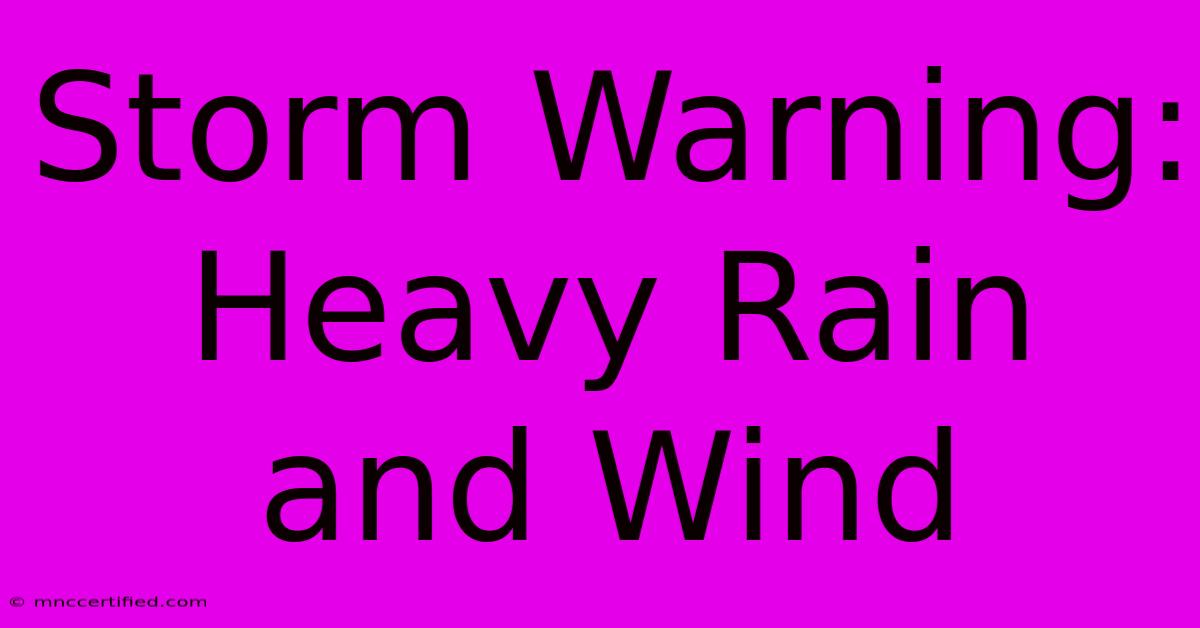Storm Warning: Heavy Rain And Wind

Table of Contents
Storm Warning: Heavy Rain and Wind – Preparing for the Worst
The roar of the wind, the lashing rain against the windows – a severe storm can be a terrifying experience. Knowing how to prepare and stay safe is crucial. This comprehensive guide will equip you with the knowledge and steps needed to weather the storm, literally! We'll cover everything from preparing your home and property to staying safe during and after the storm's passage.
Understanding the Threat: Heavy Rain and High Winds
Heavy rain and high winds are common elements of many storm systems, from thunderstorms to hurricanes and tropical storms. The combined impact can cause significant damage and disruption:
- Flooding: Heavy rainfall overwhelms drainage systems, leading to flash floods and widespread inundation. This can damage property, disrupt transportation, and even endanger lives.
- Wind Damage: High winds can uproot trees, damage power lines, and cause structural damage to buildings. Flying debris poses a significant threat to people and property.
- Power Outages: Downed power lines are a common consequence of strong winds, leading to extended periods without electricity.
- Landslides and Mudflows: In hilly or mountainous areas, heavy rain can saturate the soil, causing landslides and mudflows that can bury homes and roads.
Identifying High-Risk Areas
Before a storm hits, it's vital to assess your risk. Are you located in a flood plain? Do you live near a body of water that could overflow? Are there large, old trees near your home that could fall? Understanding your vulnerability helps you prioritize preparedness measures. Check your local weather alerts and warnings regularly for updated information.
Preparing Your Home and Property: A Pre-Storm Checklist
Proactive preparation is key to minimizing the impact of a storm. Here’s a comprehensive checklist:
- Secure your property: Bring loose objects indoors, such as patio furniture, garbage cans, and anything that could become airborne. Trim trees and shrubs to reduce the risk of damage.
- Protect your windows: Board up windows or cover them with plywood or storm shutters. If you don't have these, consider using heavy-duty tape to reinforce the glass.
- Clear gutters and drains: Clogged gutters can exacerbate flooding. Ensure they are clean and free-flowing.
- Charge devices: Make sure your cell phones, laptops, and other electronic devices are fully charged. Consider having a portable power bank as a backup.
- Gather emergency supplies: Stock up on bottled water, non-perishable food, a first-aid kit, medications, flashlights, batteries, and blankets. Consider a battery-powered radio for updates.
- Develop an evacuation plan: If you live in a high-risk area, know your evacuation routes and have a designated meeting place for your family.
Staying Safe During the Storm
When the storm hits, prioritize safety:
- Stay indoors: Avoid going outside unless absolutely necessary. If you must venture out, wear appropriate clothing and footwear.
- Stay away from windows: Strong winds and falling debris pose a significant threat.
- Monitor weather reports: Stay updated on the storm's progress through radio, television, or your smartphone.
- Be aware of flooding: Never drive or walk through floodwaters. Even shallow water can be deceptively dangerous.
- Report downed power lines: Contact your local utility company immediately if you see downed power lines.
After the Storm: Recovery and Assessment
Once the storm has passed, it's crucial to assess the damage and take appropriate steps:
- Check for injuries: Assess yourself and your family for injuries. Seek medical attention if needed.
- Inspect your home for damage: Look for structural damage, leaks, and signs of flooding.
- Avoid downed power lines: Stay away from any downed power lines and report them immediately.
- Photograph damage: Document the damage to your property for insurance purposes.
- Contact your insurance company: Report any damage to your home or property to your insurance provider.
Boosting Your Storm Preparedness: Beyond the Basics
- Invest in a generator: A generator can provide crucial power during extended outages.
- Learn CPR and first aid: Knowing these life-saving techniques can make a significant difference in an emergency.
- Create a communication plan: Establish a plan for how your family will communicate during and after the storm.
- Join your local emergency response team: This is a great way to contribute to your community and gain valuable preparedness knowledge.
By following these steps, you can significantly reduce the risk and impact of heavy rain and high winds. Remember, preparation is key to weathering the storm—both literally and figuratively. Stay safe!

Thank you for visiting our website wich cover about Storm Warning: Heavy Rain And Wind. We hope the information provided has been useful to you. Feel free to contact us if you have any questions or need further assistance. See you next time and dont miss to bookmark.
Featured Posts
-
A12 Northbound Closed Due To Multiple Crashes
Nov 18, 2024
-
Glastonbury Tickets 35 Minute Sellout
Nov 18, 2024
-
Nfl Chargers Dominate Bengals
Nov 18, 2024
-
Gk Barry Age Girlfriend Real Name
Nov 18, 2024
-
Jahandad Khans Debut Pakistans First Innings
Nov 18, 2024